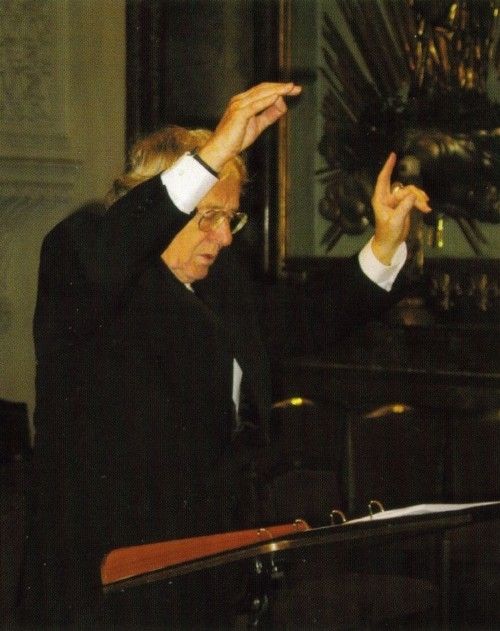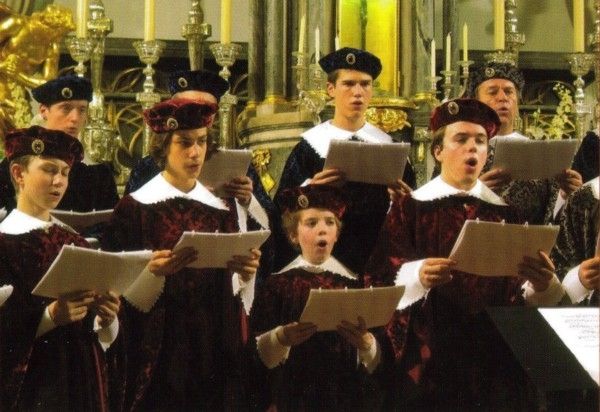

René Clemencic
René Clemencic is a composer, conductor, flute and clavichord
virtuoso, harpsichordist and organist, director and founder of a
world-famous early music consort (the Clemencic Consort), musicologist
and writer, trained philosopher as well as a collector of emblematic
books and sculptures.
Born in Vienna on 27th February 1928, he is a true child of the Danube
metropolis. His ancestors hailed from Istria, Slovenia, Moravia,
Poland, etc. The founder of the study of Germanistics, Karl Lachmann,
is among his direct ancestors on his mother's side. At home he always
spoke Italian with his father, a notary, and German with his mother.
Rene Clemencic studied philosophy and musicology at the Sorbonne in
Paris, the Collège de France and the University of Vienna, where
he obtained his doctorate with the dissertation "Being and
Consciousness in Louis Lavalle". At the same time he was studying music
— recorder and harpsichord in Vienna, Holland and Berlin, musical
form with Erwin Ratz, theory with Schoenberg's friend and student Josef
Polnauer and J. M. Hauer's twelve-note theory with Johannes Schwieger.
Since 1957 René Clemencic has appeared internationally as
recorder player and director of his own ensemble. Since 1966 he has
been in charge of the "Musica Antiqua" concert series at the
Gesellschaft der Musikfreunde in Vienna.
Well over 100 records and CDs have appeared with him as soloist and as
conductor of the Clemencic Consort and other ensembles or orchestras.
He has given concerts in every continent and received numerous prizes
such as the Edison Award, Grand Prix du Disque, Diapason d'Or, Prix
Cecilia and many others. In 1989 he was awarded the Gold Medal of
Honour of the City of Vienna, in 1996 the personal title of Professor,
in 1977 the Anima Mundi Prize of the Venice Biennale d'Arte Sacra as
well as the City of Vienna Prize.
I
n his compositions Clemencic is concerned in the first instance with
the symbolism of sound, not primarily with aesthetics. "I try to
introduce into my works sound and tonal complexes as acoustic emblems
and values representing cosmic structures. Sound and tonal gestures
should work as such in their original magic. I am not so concerned with
the production of an opus, an artefact in the usual sense, but rather
with the unveiling of certain hidden semantics in what is audibly
perceived."
René Clemencic's compositional career began with the first
performance of his work Maraviglia III at the Alpbach Forum.
Performances of his works followed in, among other places, London,
Nancy, at the Festival de Wallonie, the Evreux Festival, the Breslau
Festival of Avant-Garde Music, the Adelaide Festival, at Oberlin
College in the USA, at the Leningrad Festival of Contemporary Music, at
La Scala, Milan, the Menuhin Academy at Blonay, in Salzburg, Palermo
and at the Carinthian Summer.
His oratorio Kabbala, with a Hebrew text, received its first
performance in 1992 in the festival in Cividale del Friuli. The
Austrian premiere in 1994 in the Vienna Odeon in the course of the Week
of Jewish Culture was greeted with a storm of applause, as was the
British premiere in 1996. The Vienna "Klang-bogen" of 1993 included a
successful staging of the ballet-pantomime Drachenkampf (Fight with
the Dragon). The 1996 premiere of Apokalypsis, (a Wiener
Musikverein commission), in the Great Hall of the Vienna Musikverein
was lauded to the skies by the critics. The 1998 premiere of the piano
trio Jeruschalajim in the "Hörgänge" Festival was
greeted by, among others, the Viennese Altenberg Trio as "a valuable
enrichment of the piano trio literature". In 1999, once more in the
"Hörgänge" Festival the premiere took place of the oratorio Reise
nach Ninive (Journey to Niniveh). In May 2000 the Concerto for
Strings had its first performances in Caserta and Naples. The
premiere of his Stabat Mater took place in Todi (Umbria) at the
end of July 2001. He is presently working on an opera Daniel,
in Hebrew and Aramaic, based on the Old Testament Book of Daniel.
Clemencic Consort
The Clemencic Consort, directed by René Clemencic, is an Early
Music ensemble with an international membership, appearing in variable
formats depending on the repertoire. Singers and instrumentalists from
the whole world have taken up the task of interpreting music from the
middle ages to the baroque on historical instruments, with special
value being placed on living authenticity, while consciously avoiding
the "wagging of the scholarly finger". Programmes are designed to
convey a colourful and comprehensive image of the epoch in question.
René Clemencic has been appearing since 1957 as a recorder
virtuoso and leader of his own ensemble. Since 1966 he has run the
"Musica Antigua" series, part of the concert season of the Vienna
Musikverein. He has participated in over 100 records and CDs as soloist
and with the Clemencic Consort, many of which have secured
international prizes, including the Edison Award, Grand Prix du Disque,
Diapason d'Or and the Prix Cecilia.
The Clemencic Consort has been, and continues to be, invited to the
most important music festivals throughout the world.
Not only its hectic concert activity but also a great number of
recordings, many of which also receive awards, underline the
significance of the Clemencic Consort who, along the way, have made
accessible to a wider public many works of earlier epochs — often
for the first time.
Chorschule der Wiener Sängerknaben
Since September 2001, in addition to its boarding school, the School
has offered boys and girls aged from 4 to 14 courses in choral singing,
from elementary musical education to preparation for demanding,
specific projects.
For the recording "Sacred Music from the Court Chapel of Maximilian I",
a number of boys from the choir school were rehearsed by the schola's
voice coach, Sylvia Purcar.
Choralschola der Wiener Hofburgkapelle
The Choralschola of the Vienna Hofburgkapelle, consisting exclusively
of former members of the Vienna Boys' Choir, has been singing the
Gregorian Propers at Sunday Mass in the Chapel of the Vienna Hofburg
since 1952. Thanks to this continuing task, the Schola has developed
into an internationally-recognised vocal ensemble who, in searching for
an historically appropriate interpretation, also takes into account the
musicological findings of research into the great tradition of
Gregorian chant. A series of 6 CDs, produced between 1991 and 1997
under the direction of Father Hubert Dopf SJ., offers a view into the
rich treasures of this highly evolved art of unison singing. Alongside
these recordings, and at the invitation of Europe's most renowned music
festivals, the meditative effect of Gregorian chant, combined with
recitation or a solo instrument, has been successfully communicated to
a wide public.
A concert programme has been developed reaching back to the
establishment of the Court Chapel by Emperor Maximilian I in the late
15th century, with music by Josquin Desprez and Heinrich Isaac among
others. What makes these events unique is that the music is sung a
cappella following note-values from the highly complex original
mensuration, something requiring a huge amount of patient preparation.
Following the original example, boys' voices are introduced for the
descant parts.
Notes on the works
The period around 1500 is a turning-point. Janus-like, it looks back to
the middle ages and forwards to the new age, Gothic and Renaissance,
ending and new beginning. The Vienna Hofkapelle (Court Chapel) of
Kaiser Maximilian I stands at the apex of these changes. By 1496
Maximilian, emperor since 1493, had sent a part of his imperial chapel
establishment to Vienna, together with the highly renowned composer,
Heinrich Isaac. It was formally established in July 1498. Vienna became
its permanent seat.
At the core of the chapel establishment was the choir, a vocal ensemble
of men and boys brought together for the performance of highly evolved,
polyphonic sacred music. It was supported by trumpets and trombones.
Among the organists attached to it towered Maximilian's personal
organist, Paul Hofhaimer.
The first Kapellmeister to be appointed was Georg Slatkonia from
Laibach, later Bishop of Vienna. The well-educated and
highly-organ¡sed Slatkonia remained principal Kapellmeister even
after his appointment as Bishop. Heinrich Isaac was Court Composer
until his death in 1517, and was succeeded in office by his pupil
Ludwig Senfl.
In this recording we place alongside compositions by Maximlian's
Hofkapellmeisters Heinrich Isaac and Ludwig Senfl a Mass by Josquin
Desprez. "Josquin is the master of the notes, which must do as he
wills it; the other composers have to do as the notes will it."
(Martin Luther)
The Missa "di dadi" is in the third book of Josquin Masses,
which first appeared in 1514-1516 published by Petrucci in Venice. The
Mass is a so-called 'cantus firmus' Mass: the cantus firmus, a short
melodic fragment, literally repeated in almost every section, permeates
the whole work as a kind of spiritual bonding. It is however almost
concealed within the inner parts. This cantus firmus corresponds to the
beginning of the tenor part of the chanson N'auray je jamais mieulx
by Robert Morton, the English musician active in Burgundy between 1457
and 1476.
Following the usage of the period, Josguin's Missa "di dadi",
the Ordinary of the Mass, is accompanied by a selection of Mass Propers
and instrumental versions of motets, so as to create a meaningful whole.
The inserted sung Propers are by Heinrich Isaac. The Introit and
Alleluia are taken from the great "Choralis Constantinus", composed in
part for Constance Cathedral but mostly for the Vienna Hofkapelle.
Basic plainsong melodic structures are artfully worked out in mostly
four-part imitative writing. Sometimes the plainsong structure appears
almost unaltered in long, cantus firmus note-values.
The Magnificat is by Ludwig Senfl, His Magnificat sexti toni
artfully elaborates the plainsong Magnificat melody in mostly four-part
writing. Full account is taken of declamatory style and renaissance
tonal sensibilities in the subtle contrapuntal writing.
The instrumental contributions present instrumental versions of motets
by Josquin, Isaac and Senfl, according to the usage of the period. The
organ pieces are intabulations of contemporary motets or original
instrumental pieces.
The funeral ode Quis dabit oculis was composed by the Italian
genius Constanzo Festa, (whose works are often confused with Josquin's)
for the funeral of Ann of England, wife of the French King Louis XII.
Senfl used the music, with slight alterations appropriate for the
occasion, for the funeral ode on the death of Emperor Maximilian I
(1519).
In this recording the music is performed from the original Renaissance
notation with mensuration which, in order not to disturb the onward
flow, has no bar-lines and no full score (see illustrations on page 15
& 17).
René Clemencic
